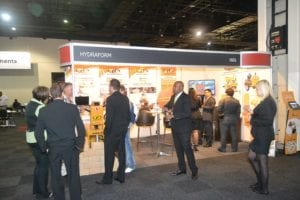Alternative building technologies were a hit at this year’s Totally Concrete Expo, which took place at the Sandton Convention Centre earlier this month.
With a dynamic approach to showcasing its product and service offering, Hydraform was a firm favourite among visitors and delegates alike.
According to Nazlie Dickson, Sales and Marketing Director for Hydraform, “We had the opportunity to host our workshop, ‘Engineered to Create Possibilities’, which covered the basics of building using our unique Hydraform Interlocking Building System, which proved very informative and interesting to clients, both old and new.”
She adds, “The blocks are produced using soil, some cement and water, after which they are dry-stacked and interlocked from top to bottom and back to front. The system saves time and money, and is ideal for business owners and entrepreneurs looking to expand their offering to the construction market.”
Supporting infrastructure development
With innumerable opportunities available in South Africa and beyond, the construction trade and exchange, both locally and abroad, are in a period of burgeoning growth and activity which looks set to stay.
Hydraform’s product offering is uniquely positioned to serve developing countries in their quest for infrastructure development and stability due to its inherent adaptability.
“Our products are able to work around infrastructural constraints and still deliver housing, public buildings, clinics and schools – even in the most remote areas in Africa,” says Dickson, adding, “Doing business in Africa has a lot to do with making the time and effort to foster the right relationships, underpinned by trust, in key localities.”
Dickson concludes, “Totally Concrete 2015 represented for us an exclusive opportunity to meet with the movers and shakers of our industry and to showcase how an innovative mix of materials, coupled with world-class machinery, can offer a quality solution to housing and infrastructure needs – both locally and globally.”








